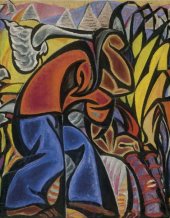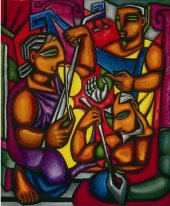 Cutting Cane
Cutting Cane
 Musical Trio
Musical Trio |
HUGH STOLLMEYER
|
| DATE OF BIRTH: |
January 13, 1912 |
| PLACE OF BIRTH: |
Santa Cruz, Trinidad |
| EDUCATION: |
... |
| CAREER: Hugh Stollmeyer was the youngest brother of Jeffrey B. Stollmeyer and Victor Stollmeyer, both of whom represented Trinidad & Tobage in cricket. He was an artistic child, always painting, reading, drawing and writing poetry and plays. When he finished school he joined the "Trinidad Independent," a group of creative thinkers who questioned the social and artistic "norm" of the day, and whose interests included the abolishment of class divisions, capitalism, racism, religious extremism, and prejudice against homosexuality. Together they published "The Beacon," a magazine that included articles on politics, sociology, and philosophy, as well as reviews of book and art exhibitions, original poetry and short stories. Hugh wrote articles on art, art restoration, and reviews of art exhibitions, as well as poetry. He exhibited with others from the Independent in Trinidad and abroad. Hugh left Trinidad for New York in the summer of 1930 and lived with his older brothers who were already working and studying there. He apprenticed at a photographic advertising company, and attended classes at the Art Students league. He continued his correspondence with the Trinidad Independent and wrote for the Beacon. In 1933, he moved back to Trinidad where he continued to exhibit his work locally and abroad and was active in the Trinidad art scene. By 1938, Hugh was increasingly uncomfortable with Trinidad society and returned to New York. His work from the late-1930s, particularly after his return to New York, marked the beginning of his artistic maturity. During this period, he captured the character and mixed ethnicity of the Trinidad people, as well as the vibrant color and the lush and varied forms of topical foliage. He was very active in the Greenwich Village creative community and spent much time frequenting the galleries, critiquing art and learning from others.
In the mid-1950s, Hugh and his friend Arthur Repkin moved to the countryside north of New York City. Hugh planted extensive gardens here and both the flowers and vegetables he grew became the subjects for his painting. By 1959, Hugh's relationship with Repkin had disintegrated and he returned to New York briefly and then to Trinidad, where he lived for the major part of each year until 1964. He immediately immersed himself in the artistic life of the island and exhibited frequently. This was a very productive period, marked by his return to painting Trinidad women, in all their diversity, surrounded by the lush vibrant color of tropical flowers and foliage.
However, Hugh's productivity and involvement in art were affected by bouts of depression which he had suffered throughout his life. His increasingly heavy drinking began to take its toll. After he returned to New York in 1964, he found it increasingly difficult to paint and stopped painting seriously in 1965. In 1966, he was asked to design the curtain for the stage at the Trinidad and Tobago Pavilion at Expo '67 in Montreal. This may have been his last work. In 1967, he went to work in the physiotherapy department at the Elmhurst Mount Sinai Hospital, New York. He viewed his work there as a kind of performance, healing through love and laughter as well as physiotherapy. He found the constant contact with people invigorating after the solitary pursuit of painting. In 1971, he left the hospital hoping to return to painting, but found that he could not. His previous work, however, was taken up by the Ligoa Duncan Gallery in Uptown Manhattan and he had exhibitions there and at their gallery in Paris. In 1976, he returned to Trinidad at his family's insistence and was treated for alcoholism. In 1977, he returned to New York where he died. For a view of Hugh Stollmeyer's works of art, see Fine Island Arts. |
| DIED: |
June 15, 1982 |
| Compiled by Ronald C. Emrit |
|



